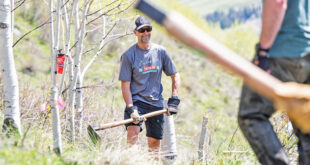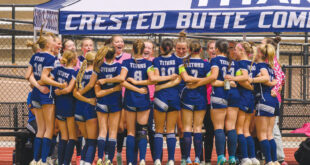“When you look at the whole thing, it’s nauseating”
by Than Acuff
Off-season offers the opportunity for many people to escape the snow and head for warmer climes.
Jeff Banks and Jake Beren typically opt otherwise. Both are guides for Irwin Guides during the winter months and when our off-season hits, Banks and Beren continue to chase the snow and ice, for both work and play, be it skiing and/or climbing in the Himalayas, the Alps or Alaska.
The two teamed up to take a stab at the Heckmair Route on the north face of the Eiger in mid-April, a route rich in history known to test the strongest alpinists with its mix of snow, rock and ice for 6,000 feet straight up.
“If you’re an alpinist, you have to climb the Eiger—there’s so much history on it,” says Banks. “It’s mythical so you gotta do it.”
“It’s an intimidatingly huge face,” says Beren. “When you look to the top it’s this cresting wave of limestone above you waiting to crush you. When you look at the whole thing, it’s nauseating.”
The two hatched the plan last December upon returning back to Crested Butte for their winter work. With a goal in mind, the two mixed training with work as best they could throughout the entire winter.
“We were dry-tooling [climbing a mix of rock and ice with crampons and ice axes] at night, in storms, as fast as we could,” says Beren.
“We took what we had here and tried to simulate the Eiger and what we thought would be the worse case scenarios on the Eiger,” says Banks. “Doing things at night, in shitty conditions. Of course, we didn’t even come close.”
“It’s a mess no matter what, it’s just what
degree of a mess it is.”
As the winter played out in the Alps, it became strikingly clear that the Eiger would be more of a test than usual.
At its best, a majority of the north face is covered in firm snow and ice for most of the way, making for more palatable yet still challenging climbing conditions for experienced alpinists. In a dry year, such as this one, it’s a completely different ball game.
“It’s a mess no matter what, it’s just what degree of a mess it is,” says Beren. “We considered there would be six pitches of technical, mixed climbing and there was so much more than that.”
“Even the easy pitches were much more desperate,” says Banks. “The slabby low-angle pitches that are typically covered in ice were just a horror show. We got more than we bargained for.”
The two headed into the night at midnight to start the climb. As things progressed they soon realized the climb was going to be a beast and while they talked about doing it in 12 hours, that timeline was soon abandoned.
“Once we started to get into the business, we realized this wasn’t the kind of route in these conditions you could do in 12 hours,” says Beren.
Still, not a word about time was spoken.
“Sometimes you don’t need to state the obvious,” says Banks. “We just knew we had to keep going until we got to the top. Slow, methodical and safe. It was going to be a sufferfest and we would have to man-up.”
Beren distinctly recalls a moment 16 hours into the climb as he was in the midst of a tough pitch, when he heard something surreal.
“I was on the hardest lead I had ever had, it was a full rope stretcher, and I could hear AC/DC’s Thunderstruck coming from the town below,” says Beren.
The two continued to push forward, dry tooling through sections at night that typically were filled with ice or firm snow, brushing away rotten snow to place gear and build anchors.
“Keep it moving, don’t f**k up,” says Beren. “It wasn’t too bad until the end of the first day.”
“The relentless nature of having to do an infinite number of delicate and heady pitches takes its toll.”
Twenty-six hours of continuous climbing into it, the two reached their max. Banks led up a pitch called the Exit Crack that, again, is typically filled with firm snow making for easier climbing. Instead, Banks found more rotten snow and dry conditions, forcing him to dry tool up another pitch in the cold and dark of night.
“After I led that pitch I was like, this is over the limit,” explains Banks. “The relentless nature of having to do an infinite number of delicate and heady pitches takes its toll.”
Beren followed up to join Banks and that’s when they decided enough was enough—it was time to stop, at least for a little while.
“Jake came up with the idea to rappel back down to the start of the pitch and revaluate the situation,” says Banks.
“There was this little hump of snow and we chopped out a bench in the ice and snow to rest,” says Beren.
Because the plan was to finish the climb in 12 hours, maybe 18, without sleep, they had to rely on space blankets as their bivy sacs. Unfortunately, those space blankets had been sitting in their packs for the better part of 10 years.
“It was windy and when we opened them up, one just disintegrated,” says Banks. “We put one space blanket over our laps and we just slept like a kid in class with his head on the desk.”
In addition, food and water was low to non-existent, with plenty of climbing left and a storm on the way.
“That was a nice little boost to see something beautiful that wasn’t scary.”
After their rest, Beren reached into his stash, “Jake Beren doesn’t run out of food and water,” found half of a Snickers bar for Banks, the sun came up and they went back to it.
“Once we started climbing again, we were going to the top,” says Beren.
“You can’t retreat off of the face at that point,” adds Banks.
Banks led back up the first pitch of the Exit Crack and the two continued on, methodically alternating leading each pitch as it came.
“We got into this rhythm where each person would step up when it was their turn,” says Banks.
With the thought of a storm in the back of their heads, they reached the ice field section hoping for a bit of a reprieve from the constant dry tooling and mixed climbing.
“The ice field wasn’t an ice field,” says Beren. “It was still unconsolidated snow on crappy rock. Still had to clear off holds and excavate along the way.”
Amidst all of the grueling climbing, now over 30 hours into their ascent and no chance at backing off, Beren was offered a welcome sight when he reached the ridge at 10 a.m., a brocken spectre. A brocken spectre is when your shadow is cast on clouds below and haloed by a rainbow.
“That was a nice little boost to see something beautiful that wasn’t scary,” says Beren.
“As long as you kept in the puddle, it was fine.”
Yet it was still business time as the storm had now moved in and they had to negotiate a knife-edge ridge covered in blue ice to reach the summit.
“We’re essentially up in a cloud at that point with a coil of rope in hand so that if one guy falls off one side, you jump off the other side to stop the fall,” explains Beren.
They reached the summit in the storm and then turned to the west face for a 5,000-foot descent on snow and ice, almost straight down.
“We knew people had trouble in the past coming down—after 30-plus hours you’re so tired,” says Beren. “We just knew to take it slow and pay attention. As long as you kept in the puddle, it was fine.”
Upon reaching a hotel in Interlaken, Switzerland 38 hours later, they were taken in and once the hotelier and neighboring restaurant manager heard of their effort, they were treated to the spoils of the accommodations.
“We just sat by the fire and ordered up a couple of Weiss beers,” says Banks. “The Italian chef then just kept bringing us Weiss beers and food.”
Two weeks after the climb, both Beren and Banks are still processing what they had been through.
“I learned a lot on that climb,” says Beren. “I had to step it up and I’m better for it. I wouldn’t want to do it all the time but I’m glad I did it.”
“Physically it was demanding and because the route was so dry it was technically even more demanding,” says Banks. “Mentally, it was super-demanding. Strangely enough, we were having a good time but I don’t think either of us is that eager to repeat that. It was incredibly satisfying building up to something like that and to be able to do it.”
 The Crested Butte News Serving the Gunnison Valley since 1999
The Crested Butte News Serving the Gunnison Valley since 1999


